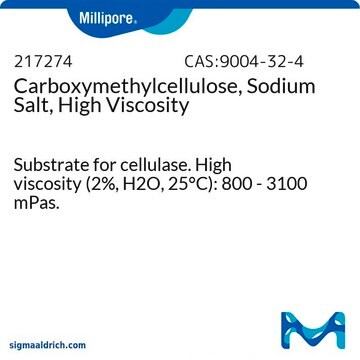추천 제품
생물학적 소스
synthetic (organic)
형태
powder
색상
light yellow
유용한 pH 범위
(20 °C, 10 g/L, 68 °F neutral)
점도
50-200 cP, 4 % in H2O(25 °C)
mp
> 300.05 °C ((> 572.09 °F ))
solubility
water: soluble
양이온 미량물
Na: 6.5-9.5%
저장 온도
room temp
InChI
1S/C6H12O6.C2H4O2.Na/c7-1-3(9)5(11)6(12)4(10)2-8;1-2(3)4;/h1,3-6,8-12H,2H2;1H3,(H,3,4);
InChI key
DPXJVFZANSGRMM-UHFFFAOYSA-N
유사한 제품을 찾으십니까? 방문 제품 비교 안내
일반 설명
This product is a low viscosity carboxymethylcellulose (CMC); the viscosity of a 4% solution in water at 25 oC is 50-200 centipoise (cps). The viscosity is both concentration and temperature dependent. As the temperature increases, the viscosity decreases. As the concentration increases, the viscosity increases. Low, medium and high viscosity carboxymethylcellulose (CMC) are all used as suspending agents. Low viscosity CMC is usually used in "thin" aqueous solutions. Medium viscosity CMC is used to make solutions that look like a syrup. High viscosity CMC is used to make a mixture, which resembles a cream or lotion.
애플리케이션
Soluble carboxymethylcelluloses (CM-cellulose; CMC) available in varying viscosities are used as viscosity modifiers (thickeners) to stabilize emulsions and as a chemical dispersants of oils and other carbon structures such as nanotubes. CMCs are used in the development of biostructures such as biofilms, emulsions and nanoparticles for drug delivery. Carboxymethylcellulose, low viscosity, may be used to make solutions the consistency of "thin" aqueous solutions.
제조 메모
The product is soluble in water (40 mg/mL).The key to dissolving carboxymethylcellulose is to add the solid carefully to the water so that it is well dispersed (well-wetted). Adding the solid in portions may be necessary. Adding water to the dry solid produces a "clump" of solid that is very difficult to dissolve; the solid must be added to the water. Stir gently or shake intermittently; do not stir constantly with a magnetic stirring bar. High heat is not needed and may actually slow down the solubilization process. A mixing device, such as an impeller-type agitator which produces a vortex, would allow the powder to be drawn into the liquid, but it may produce some shearing.
The product is soluble in water (40 mg/mL).The key to dissolving carboxymethylcellulose is to add the solid carefully to the water so that it is well dispersed (well-wetted). Adding the solid in portions may be necessary. Adding water to the dry solid produces a "clump" of solid that is very difficult to dissolve; the solid must be added to the water. Stir gently or shake intermittently; do not stir constantly with a magnetic stirring bar. High heat is not needed and may actually slow down the solubilization process. A mixing device, such as an impeller-type agitator which produces a vortex, would allow the powder to be drawn into the liquid, but it may produce some shearing.
Under normal conditions, the effect of temperature on solutions of this product is reversible, so slight temperature variation has no permanent effect on viscosity. However, long periods of heating CMC solutions at high temperatures (autoclaving) will degrade the product and permanently reduce viscosity. CMC is therefore very difficult to sterilize. γ-Irradiation, like heating, will degrade CMC. High viscosity CMC is more adversely affected by autoclaving and irradiation than is low viscosity CMC. Filtering CMC solutions tends to leave a gel behind because the material is fibrous, so solutions cannot be sterile filtered.
Under normal conditions, the effect of temperature on solutions of this product is reversible, so slight temperature variation has no permanent effect on viscosity. However, long periods of heating CMC solutions at high temperatures (autoclaving) will degrade the product and permanently reduce viscosity. CMC is therefore very difficult to sterilize. γ-Irradiation, like heating, will degrade CMC. High viscosity CMC is more adversely affected by autoclaving and irradiation than is low viscosity CMC. Filtering CMC solutions tends to leave a gel behind because the material is fibrous, so solutions cannot be sterile filtered.
기타 정보
To gain a comprehensive understanding of our extensive range of Polysaccharides for your research, we encourage you to visit our Carbohydrates Category page.
Storage Class Code
11 - Combustible Solids
WGK
WGK 1
Flash Point (°F)
Not applicable
Flash Point (°C)
Not applicable
개인 보호 장비
Eyeshields, Gloves, type N95 (US)
시험 성적서(COA)
제품의 로트/배치 번호를 입력하여 시험 성적서(COA)을 검색하십시오. 로트 및 배치 번호는 제품 라벨에 있는 ‘로트’ 또는 ‘배치’라는 용어 뒤에서 찾을 수 있습니다.
이미 열람한 고객
R Farenzena et al.
Journal of animal physiology and animal nutrition, 101(5), 1057-1066 (2016-07-28)
Two in vivo digestibility trials with sheep were conducted to identify the minimum period length of feeding a new diet to obtain reproducible values of nutritional variables onward and the minimum length of collection period as to obtain maximal precision for
Shigenobu Mitsuzawa et al.
Scientific reports, 7(1), 16320-16320 (2017-11-28)
The glycoside hydrolase family 7 (GH7) member cellobiohydrolase (CBH) is a key enzyme that degrades crystalline cellulose, an important structural component of plant cell walls. As GH7 CBH is a major component in the enzyme mixture used to degrade biomass
C Philippeau et al.
Journal of dairy science, 100(4), 2637-2650 (2017-02-06)
This study investigated the effects of bacterial direct-fed microbials (DFM) on ruminal fermentation and microbial characteristics, methane (CH
Vinay Khatri et al.
Biotechnology for biofuels, 11, 144-144 (2018-05-26)
Pretreatment of lignocellulosic biomass (LCB) is a key step for its efficient bioconversion into ethanol. Determining the best pretreatment and its parameters requires monitoring its impacts on the biomass material. Here, we used fluorescent protein-tagged carbohydrate-binding modules method (FTCM)-depletion assay
Tim Wartewig et al.
Nature, 552(7683), 121-125 (2017-11-17)
T cell non-Hodgkin lymphomas are a heterogeneous group of highly aggressive malignancies with poor clinical outcomes. T cell lymphomas originate from peripheral T cells and are frequently characterized by genetic gain-of-function variants in T cell receptor (TCR) signalling molecules. Although
자사의 과학자팀은 생명 과학, 재료 과학, 화학 합성, 크로마토그래피, 분석 및 기타 많은 영역을 포함한 모든 과학 분야에 경험이 있습니다..
고객지원팀으로 연락바랍니다.

